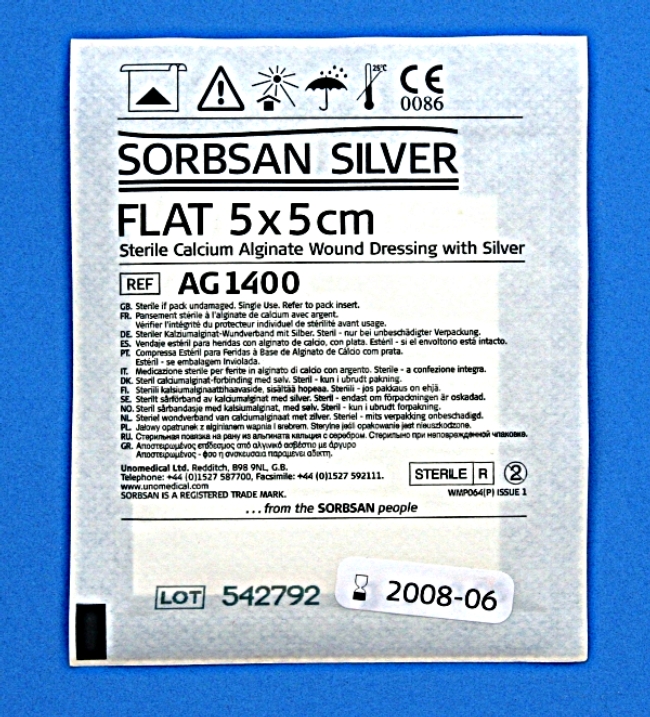
| Product Name: | Sorbsan Silver |
| Classification Name: | Dressing Calcium Alginate with Silver |
| Manufacturer: | Aspen Medical Europe |

Sorbsan Silver is made from the calcium salt of alginic acid, prepared as a textile fibre. The alginate fibres from which the dressing is manufactured also contains 1.5% silver which gives the normally white alginate fleece a mottled brown appearance. The dressing is presented as a loose rope (unopened pack shot) for packing for cavities, a ribbon for narrow wounds or sinuses, and a flat non-woven pad for application to larger open wounds. When in contact with serum, wound exudate, or solutions containing sodium ions, the insoluble calcium alginate is partially converted to the soluble sodium salt, forming a hydrophilic gel which overlays the wound and provides a micro-environment that is believed to facilitate wound healing. In the presence of liquid, silver ions are released from the alginate fibres and these impart an antimicrobial effect to the gel formed within the local wound environment.
Sorbsan Silver may be applied to most types of exuding lesions when infection is present or suspected. For leg ulcers, pressure areas, donor sites, and most other superficial granulating wounds the sheet is usually the presentation of choice but for deeper cavity wounds and sinuses, the packing and ribbon forms are generally preferred. The dressing may be of value as an adjunct to the systemic treatment of grossly infected or malodorous wounds and for the management of painful wounds when removal of other more traditional dressings causes unacceptable levels of pain or trauma.
Because the dressing requires moisture to release the silver ions, it will be of little value if applied to wounds that are very dry, or covered with hard black necrotic tissue. Although there are no known contra-indications to the use of Sorbsan Silver, it should not be used on individuals who are known to be sensitive to silver.
Sorbsan Silver is placed on the wound surface and covered with a sterile secondary dressing held in place with surgical tape or a bandage as appropriate. The nature of the secondary dressing will be governed by the condition of the wound. If large quantities of exudate are anticipated, a simple absorbent dressing pad may be required; but as the wound heals and less exudate is produced, a thinner secondary dressing with a wound contact layer consisting of a perforated plastic film may help to conserve moisture and prevent the wound drying out too quickly. Deeper cavity wounds or sinuses may be dressed with Sorbsan Silver packing or ribbon, which should be placed gently in position but not packed in too tightly. It has been reported that a small percentage of patients experience a mild `drawing' or `burning' sensation immediately after the application of an alginate dressing to a dry wound bed. This sensation, which is usually transient, is thought to be due to the hydrophilic nature of the dressing causing temporary localised drying of the surface of the wound. This discomfort may generally be prevented by moistening the surface of the wound with a small quantity of sterile normal saline prior to the application of the dressing. Because alginate fibre reacts with sodium ions to form a soluble gel, the dressing may be removed by irrigation with sterile normal saline. This may be accomplished without causing either damage to the wound or pain to the patient.
The interval between dressing changes will depend entirely upon the state of the wound. Sorbsan Silver applied to heavily exuding or sloughy wounds may need replacing daily initially but as healing progresses and the amount of exudate decreases, the interval between changes may be extended to two or three days. At this stage a change to an alternative dressing should be considered.
Clinically infected wounds dressed with Sorbsan Silver should be carefully monitored and systemic antibiotic therapy considered if the infection does not resolve.
The flat dressings are presented individually packed in peel pouches, sterilised by Gamma, the packing is presented in vacuum formed plastic trays. Both the Ribbon and Packing cavity presentations are supplied with a sterile medical probe.
Sorbsan Silver is available in a range of sizes as follows;
1. Thomas S. Alginate dressings in surgery and wound management - part 1. Journal of Wound Care 2000;9(2):56-60.
2. Thomas S. Alginate dressings in surgery and wound management - part 2. Journal of Wound Care 2000;9(3):115-119.
3. Thomas S. Alginate dressings in surgery and wound management - part 3. Journal of Wound Care 2000;9(4):163-166.
Further information on obtaining Aspen Medical Europe products is available on the Aspen Medical Europe web site.
Further information on obtaining Sorbsan Silver products is available on
the
Sorbsan Silver
web site.
| Revision Author | Dr S. Thomas |
| Revision No | 1.3 |
| Revision date | 2009/04/14 |
This datacard has been prepared from data provided by the manufacturer and/or from published literature.